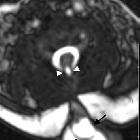Terminal myelocystocele

Terminal
myelocystocele • Terminal myelocystocele - Ganzer Fall bei Radiopaedia
Terminal myelocystoceles are an uncommon form of spinal dysraphism representing marked dilatation of the central canal of the spinal cord, herniating posteriorly through a dorsal spinal defect. The result is a skin-covered mass in the lower lumbar region, consisting of an ependyma-lined sac.
Epidemiology
Terminal myelocystoceles are more common in females .
Clinical presentation
Typically a skin covered lower lumbar mass is encountered, with or without neurological deficits .
Pathology
Although terminal myelocystoceles are found sporadically as isolated abnormalities, they are also encountered with a number of other congenital malformations, including the OEIS complex (omphalocele, bladder exstrophy, imperforate anus, and sacral agenesis) .
Siehe auch:

 Assoziationen und Differentialdiagnosen zu Terminal myelocystocele:
Assoziationen und Differentialdiagnosen zu Terminal myelocystocele:
